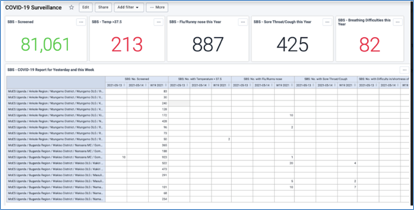Esta página ha sido traducida de manera automática y puede contener errores
Vinculación de la vigilancia escolar y nacional de COVID-19 en Uganda
HISP Uganda ha apoyado un proyecto piloto que vincula los datos de detección de coronavirus entre los sectores educativo y sanitario utilizando DHIS2
La pandemia de COVID-19 ha afectado enormemente al sector educativo en Uganda. El bloqueo inicial que se instauró en marzo de 2020 supuso que más de 15 millones de alumnos permanecieran sin escolarizar durante más de 5 meses. A pesar de las intervenciones del gobierno, que incluyeron la distribución de materiales de autoaprendizaje y el uso de clases en línea, televisadas y por radio, la mayoría de los alumnos -especialmente en las zonas rurales- no pudieron acceder a estas alternativas de aprendizaje debido a la limitada disponibilidad de electricidad y conectividad a Internet, así como a la dedicación de los alumnos a las tareas domésticas durante el horario escolar.
En julio de 2020, los centros de enseñanza de Uganda reabrieron sus puertas de forma escalonada, empezando por las clases para candidatos. La reapertura de las escuelas estaba vinculada al establecimiento y estricto cumplimiento de procedimientos operativos estándar en las escuelas para prevenir la propagación de COVID-19, como el distanciamiento social, el uso obligatorio de mascarillas y el lavado de manos. Sin embargo, quedó claro que existía una laguna en la forma de compartir la información sobre casos sospechosos y confirmados de COVID-19: ¿Cómo podían las escuelas llevar a cabo la vigilancia escolar rutinaria, la notificación y la remisión de casos sospechosos al centro más cercano, dado que los sistemas existentes en los sectores educativo y sanitario no estaban vinculados entre sí?
Aprovechamiento de la capacidad existente para vincular los datos de vigilancia COVID-19 entre educación y sanidad con DHIS2

Aprovechando la experiencia de la aplicación del DHIS2 vigilancia y respuesta integradas electrónicas a las enfermedades (eIDSR) para Vigilancia COVID-19 en el sector sanitario y la DHIS2 para la Educación (conocido localmente como DEMIS) en el sector escolar, HISP Uganda y Save the Children Uganda trabajaron en colaboración con los Ministerios de Sanidad y Educación para poner a prueba el uso de DHIS2 en la vigilancia escolar en los distritos de Wakiso y Ntungamo.
Las escuelas pudieron examinar diariamente a los alumnos y al personal en busca de signos y síntomas relacionados con la COVID-19 y enviar cifras agregadas utilizando el código corto SMS a un número gratuito para facilitar el envío de datos a DHIS2 en zonas con acceso limitado a Internet. Se creó un cuadro de mandos en DHIS2-DEMIS al que accedieron los equipos de vigilancia COVID-19 a nivel de distrito y central. A continuación, los equipos de vigilancia hacían un seguimiento de los casos sospechosos con los administradores de las escuelas para remitir los casos al centro más cercano para su posterior detección y tratamiento.

Además de los datos comunicados directamente al sistema DHIS2, los datos de los centros escolares que utilizaban un sistema alternativo (denominado XULDIME) se integraron en el sistema DHIS2 para la Educación y se visualizaron en los paneles de vigilancia escolar para ofrecer una imagen más completa. A finales de junio de 2021, otros dos distritos de Gulu y Mayuge se incluyeron en el proyecto piloto y recibieron formación sobre la elaboración de informes de vigilancia escolar.
Planificación de un despliegue a escala nacional basado en los resultados del piloto
El proyecto piloto de DHIS2 para la vigilancia escolar de COVID-19 se limitó a las escuelas primarias de cuatro distritos de Uganda. Los resultados de este proyecto piloto se compartieron con los distintos grupos de trabajo del Ministerio de Sanidad y del Ministerio de Educación y Deporte. Sobre la base de estos resultados, los ministerios encargaron al equipo la elaboración de un plan nacional de ampliación para informar sobre la expansión de la vigilancia escolar DHIS2 a todas las instituciones de enseñanza del país y orientar la reapertura de estas instituciones a partir de septiembre de 2021.
¿Quiere saber más? Puede hacer preguntas y añadir comentarios sobre este proyecto en la Comunidad de Práctica DHIS2, leer un post del equipo en el sitio web de GPE KIX, y ver una presentación de HISP Uganda del Simposio DHIS2 2021.


